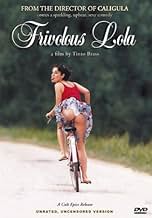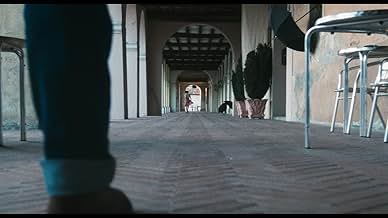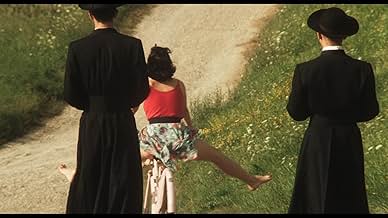Set in the 1950s Italian countryside, the film tells the story of Lola and Masetto, a young couple whose views on premarital sex differ drastically.Set in the 1950s Italian countryside, the film tells the story of Lola and Masetto, a young couple whose views on premarital sex differ drastically.Set in the 1950s Italian countryside, the film tells the story of Lola and Masetto, a young couple whose views on premarital sex differ drastically.
Max Parodi
- Masetto
- (as Mario Parodi)
Tinto Brass
- Orchestra Conductor
- (uncredited)
Storyline
Did you know
- TriviaTinto Brass met his leading lady, Anna Ammirati, when he accidentally crashed his car into her as she was bicycling. Though she was unharmed, Anna jokingly told Tinto that unless he cast her in his latest film, she would report him to the police.
- GoofsWhen Lola rides to the bakery, she encounters a running cyclist in modern attires. The film is set in 1950.
- SoundtracksMona Monella
Written by Pino Donaggio and Tinto Brass
Performed by Anna Ammirati
Pino Donaggio
Timbras - Emi
Featured review
This was only my 3rd Brass after CALIGULA (1979) - which I watched in London - and DEADLY SWEET (1967; his best film by far, so far) - viewed during the Italian B-movie retrospective at the 2004 Venice Film Festival.
Well, frivolous is right as nothing much happens during the course of the film; at least, though, it's lighthearted - unlike, say, Bigas Luna's BAMBOLA (1996; see review above) - even if in a vulgar way and, given the explicit nature of its copious nudity, occasionally erotic. Still, the leading performance by non-professional (and perennially giggly) Anna Ammirati - whom Brass reportedly discovered, literally, by way of a car accident! - is annoyingly one-dimensional. Like BAMBOLA, the leading lady's mother is played by a well-known actress (i.e. known more for her physical attributes than her acting talent), Serena Grandi - who had earlier starred in Brass' MIRANDA (1985). A surprising cast member is Patrick Mower as Grandi's suave but lewd lover (who naturally has his eyes on her daughter too); I was only familiar with him from two good British horror flicks - THE DEVIL RIDES OUT (1968) and CRY OF THE BANSHEE (1970) - and I wonder how he came to be involved with smut such as this (and, moreover, in Italy)!
One of the most notable (but not necessarily noteworthy) elements in the film is the soft-focus cinematography; it's practically shot like that all the way through, which rather kills its intended effectiveness! Brass himself appears as a bandleader at the beginning and end of the movie, the latter during the interminable wedding scene (which rather reminded me of the similar conclusion to Federico Fellini's AMARCORD [1973], also a film with the emphasis on sex and vulgarity but undeniably superior!).
Well, frivolous is right as nothing much happens during the course of the film; at least, though, it's lighthearted - unlike, say, Bigas Luna's BAMBOLA (1996; see review above) - even if in a vulgar way and, given the explicit nature of its copious nudity, occasionally erotic. Still, the leading performance by non-professional (and perennially giggly) Anna Ammirati - whom Brass reportedly discovered, literally, by way of a car accident! - is annoyingly one-dimensional. Like BAMBOLA, the leading lady's mother is played by a well-known actress (i.e. known more for her physical attributes than her acting talent), Serena Grandi - who had earlier starred in Brass' MIRANDA (1985). A surprising cast member is Patrick Mower as Grandi's suave but lewd lover (who naturally has his eyes on her daughter too); I was only familiar with him from two good British horror flicks - THE DEVIL RIDES OUT (1968) and CRY OF THE BANSHEE (1970) - and I wonder how he came to be involved with smut such as this (and, moreover, in Italy)!
One of the most notable (but not necessarily noteworthy) elements in the film is the soft-focus cinematography; it's practically shot like that all the way through, which rather kills its intended effectiveness! Brass himself appears as a bandleader at the beginning and end of the movie, the latter during the interminable wedding scene (which rather reminded me of the similar conclusion to Federico Fellini's AMARCORD [1973], also a film with the emphasis on sex and vulgarity but undeniably superior!).
- Bunuel1976
- Aug 17, 2006
- Permalink
- How long is Frivolous Lola?Powered by Alexa
Details
- Runtime1 hour 45 minutes
- Color
- Sound mix
- Aspect ratio
- 1.66 : 1
Contribute to this page
Suggest an edit or add missing content



























